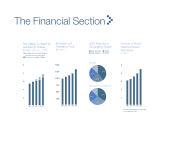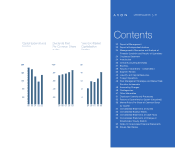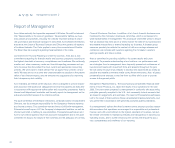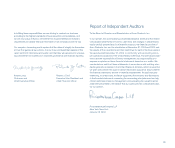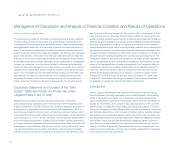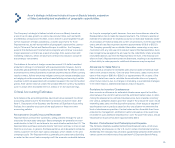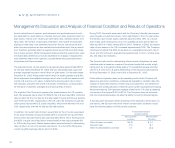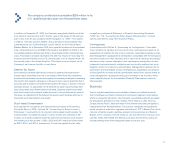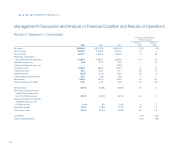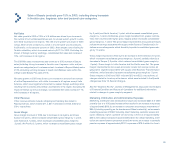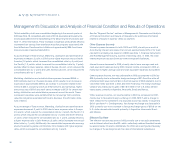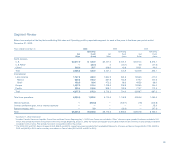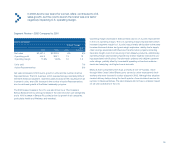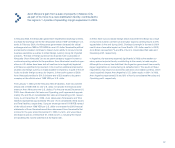Avon 2003 Annual Report Download - page 8
Download and view the complete annual report
Please find page 8 of the 2003 Avon annual report below. You can navigate through the pages in the report by either clicking on the pages listed below, or by using the keyword search tool below to find specific information within the annual report.
The company contributed a cumulative $205 million to its
U.S. qualified pension plan over the past three years.
In addition, at December 31, 2003, the Company recognized a liability on its bal-
ance sheet for each pension plan if the fair value of the assets of that pension
plan is less than the accumulated benefit obligation, or “ABO.” This liability
is called a “minimum pension liability” and is recorded in Accumulated other
comprehensive loss in Shareholders’ equity (deficit) on the Consolidated
Balance Sheets. As of December 2003, Avon reported a balance in Accumulated
other comprehensive loss of $285.8 (the balance was $288.5 in 2002) in the
Consolidated Balance Sheets (see Note 5, Accumulated Other Comprehensive
Loss). This balance primarily represents the after-tax impact of recording the
minimum pension liability for the U.S. pension plan, and to a lesser extent, for
the pension plan in the United Kingdom. This balance has no impact on the
Company’s net income, liquidity or cash flows.
Deferred Tax Assets
Avon records a valuation allowance to reduce its deferred tax assets to the
amount that is more likely than not to be realized. While Avon has considered
projected future taxable income and ongoing tax planning strategies in assessing
the need for the valuation allowance, in the event Avon were to determine that it
would be able to realize a net deferred tax asset in the future, in excess of the net
recorded amount, an adjustment to the deferred tax asset would increase earn-
ings in the period such determination was made. Likewise, should Avon deter-
mine that it would not be able to realize all or part of its net deferred tax asset in
the future, an adjustment to the deferred tax asset would decrease earnings in
the period such determination was made.
Stock-based Compensation
Avon applies the recognition and measurement principles of Accounting
Principles Board (“APB”) Opinion 25, “Accounting for Stock Issued to
Employees,” in accounting for its long-term stock-based incentive plans. No
compensation cost related to grants of stock options was reflected in Net
income, as all options granted under the plans had an exercise price equal to
the market price. Net income in 2003, 2002 and 2001 would have been lower
by $28.7, $30.1 and $27.6, respectively, if Avon had applied the fair value
recognition provisions of Statement of Financial Accounting Standards
(“FAS”) No. 123, “Accounting for Stock-Based Compensation,” to stock
options (see Note 8, Long-Term Incentive Plans).
Contingencies
In accordance with FAS No. 5, “Accounting for Contingencies,” Avon deter-
mines whether to disclose and accrue for loss contingencies based on an
assessment of whether the risk of loss is remote, reasonably possible or prob-
able. Management’s assessment is developed in consultation with the Company’s
outside counsel and other advisors and is based on an analysis of possible
outcomes under various strategies. Loss contingency assumptions involve
judgments that are inherently subjective and can involve matters that are in
litigation, which by its nature is unpredictable. Management believes that its
assessment of the probability of loss contingencies is reasonable, but because
of the subjectivity involved and the unpredictable nature of the subject matter at
issue, management’s assessment may prove ultimately to be incorrect, which
could materially impact the Consolidated Financial Statements in current or
future periods.
Business
Avon is a global manufacturer and marketer of beauty and related products.
Avon’s business is primarily comprised of one industry segment, direct selling,
which is conducted worldwide. The Company’s reportable segments are based
on geographic operations in four regions: North America, Latin America,
Europe and the Pacific. Sales are made to the ultimate consumer principally by
independent Avon Representatives. The product categories include Beauty,
which consists of cosmetics, fragrance and toiletries (“CFT”); Beauty Plus, which
consists of fashion jewelry, watches, apparel and accessories; and Beyond
Beauty, which consists of home products, gift and decorative products and
candles. Sales from Health and Wellness products and the Mark. brand are
included among these three categories based on product type.
27

